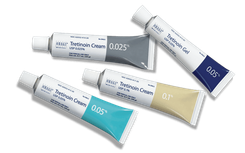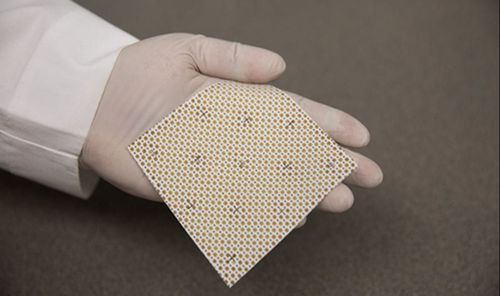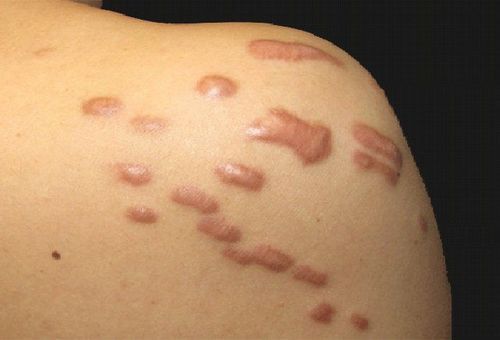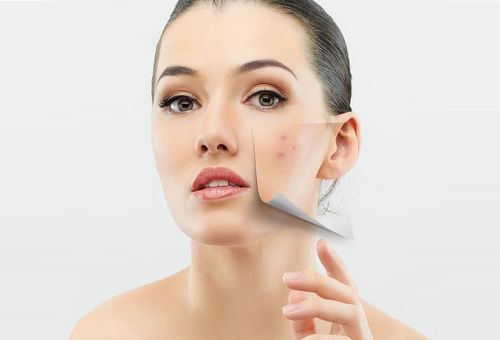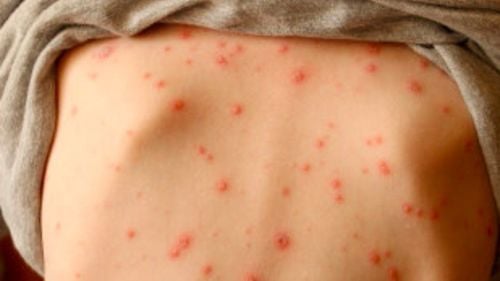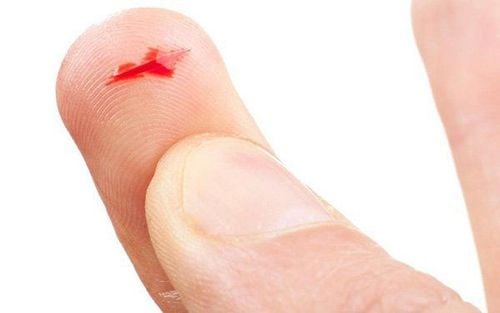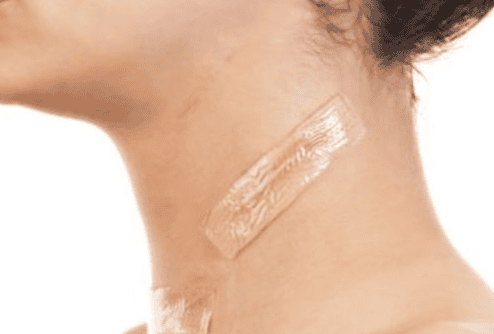Newly formed keloid scars will quickly increase in size, even spreading beyond the initially damaged area, rising higher, and may be pink, red, the same color as the surrounding skin, or darker.
1. How to treat newly formed keloid scars?
Dermatologists can usually diagnose newly formed keloid scars quickly by examining them, especially in individuals who have a tendency to form keloids.
In cases where the newly formed keloid scar appears to be a concerning skin growth, the dermatologist may perform a skin biopsy right away. This technique involves removing a small portion of the scar tissue to be examined under a microscope. If the result is benign, the doctor will proceed with treatment for the newly formed keloid, promising better outcomes.
Typically, a dermatologist may suggest more than one treatment method for the patient to choose from, depending on what is most suitable for them. Sometimes, keloid scars can be difficult to remove, while others may recur after treatment. Therefore, using two or more treatment methods together often improves the long-term results. Before meeting with the dermatologist, the patient should think about the answers to the following questions:
- Is it important to alleviate symptoms like pain or itching caused by the keloid?
- Would flattening or softening the keloid help make you feel more comfortable?
- If the keloid is on the ear, is the main goal to wear earrings again?
- Understanding what the patient expects will help the dermatologist provide realistic information about the available treatment methods for newly formed keloids:
1.1. Corticosteroid Injections and Scar
Formation Inhibitors These injections are typically part of the keloid treatment plan as soon as a keloid forms. When injected into the keloid, these medications help shrink the scar.
Patients usually receive a series of injections once every three to four weeks. On average, patients need to return for about four sessions of these injections. The first injections tend to reduce symptoms and make the keloid softer.
Between 50% and 80% of keloids shrink after being injected. However, many of these keloids will grow back within 5 years. To improve the results, dermatologists often add another treatment to the initial treatment plan.
1.2. Surgical Removal of Keloid Scars
Although this may seem like a long-term solution, nearly 100% of keloids will return after treatment. Dermatologists still need to apply this method if the scar develops too quickly and when other methods are unlikely to achieve results if done alone.
Therefore, to reduce the risk of the keloid returning after surgery, dermatologists often treat the patient with another keloid treatment method, such as corticosteroid injections or cryotherapy, to help minimize the risk. If the keloid is located on the earlobe, wearing special earrings that apply pressure to the earlobe can prevent the keloid from returning.
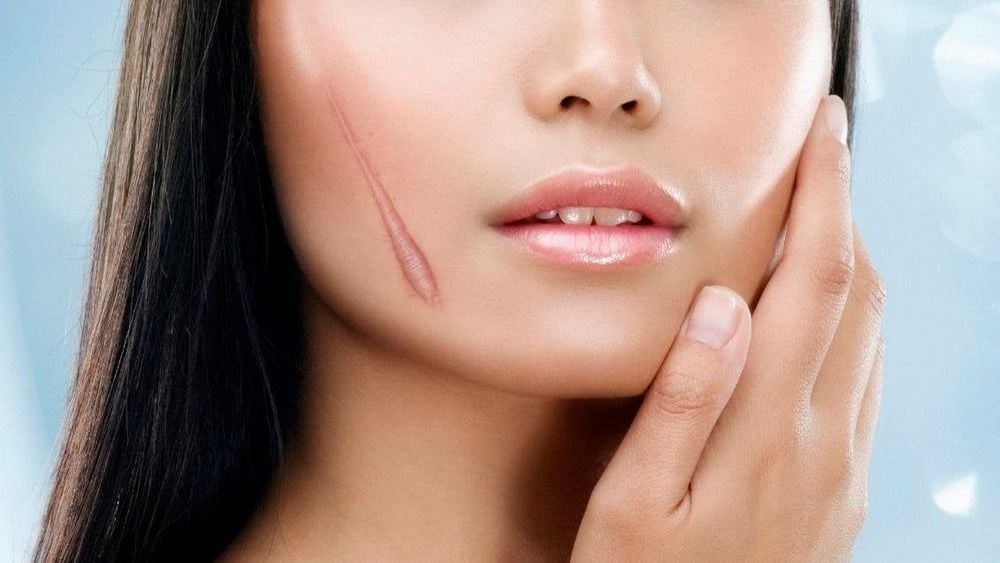
1.3. Wearing Earrings, Bandages, or Compression Garments
These methods are also commonly used after keloid surgery to prevent newly formed keloids from developing. Applying pressure to the area reduces blood flow, which may prevent the keloid from returning. Between 90% and 100% of patients who use this treatment method as directed after keloid surgery can prevent the development of another keloid.
However, following this method as instructed may be uncomfortable for the patient. To achieve optimal results, the patient must wear the treatment for up to 16 hours a day for 6 to 12 months. Among these, pressure earrings tend to be the most comfortable and are often recommended after a dermatologist removes a keloid from the earlobe.
1.4. Laser Treatment
This can reduce the size and fade the color of the keloid. This treatment is typically used in conjunction with another treatment, such as corticosteroid injections or pressure therapy.
1.5. Silicone Sheets and Gels
These can be used along with pressure therapy to prevent newly formed keloids from returning.
Sometimes, silicone can also be used alone to flatten keloids. In one study, 34% of keloid scars showed some flattening after patients used silicone gel daily for six months.
1.6. Cryotherapy
This treatment freezes the newly formed keloid from the inside out while preserving the skin layer underneath the keloid. This treatment is used to reduce the hardness and size of the keloid, making it most effective for smaller keloids.
Additionally, using cryotherapy before (or after) corticosteroid injections may reduce the size of the keloid, making the injections more effective. Dermatologists have discovered that patients who undergo three or more therapies, including cryotherapy, achieve the best results.
1.7. Radiation Therapy
Radiation therapy after your dermatologist has surgically removed the keloid can prevent a new keloid from forming. In fact, this treatment may begin immediately after surgery, the next day, or a week afterward.
In some cases, radiation energy can also be used alone to reduce the size of the keloid. However, results tend to be better when used after keloid surgery.
1.8. Tying
If a surgical thread can be tied around the keloid, gradually cutting into the keloid may cause it to detach on its own. In this case, the dermatologist will tie a new surgical thread around the newly formed keloid every two to three weeks.
2. How to treat newly formed keloids at home
Unlike the invasive methods mentioned above, which still carry the risk of new keloids forming in the future, home treatments may not completely eliminate the keloid but can certainly reduce its size, pain, and inflammation. Therefore, before seeing a dermatologist, when a keloid first forms, you may try the following natural remedies:
2.1. Apple Cider Vinegar
As a natural astringent and exfoliant, apple cider vinegar prevents cells from promoting scar tissue at the keloid site, reducing both the pigmentation and size of the keloid. Additionally, the irritated skin will calm down and swelling will subside when apple cider vinegar is applied.
Dilute apple cider vinegar with a little water and apply it to the newly formed keloid with a cotton ball. Keep it on the skin for 30 minutes, then rinse with clean water. Repeat this twice a day for one month to effectively reduce the scar.
2.2. Aloe Vera Gel
Known for its anti-inflammatory and soothing properties, aloe vera gel is a common ingredient in skincare formulas. Specifically, it plays an important role in reducing the size of keloids and also minimizes pain, inflammation, and helps heal newly formed keloid tissue.
Apply fresh aloe vera gel directly to the affected scar tissue and leave it overnight. Do this twice a day for one month to eliminate the keloid.
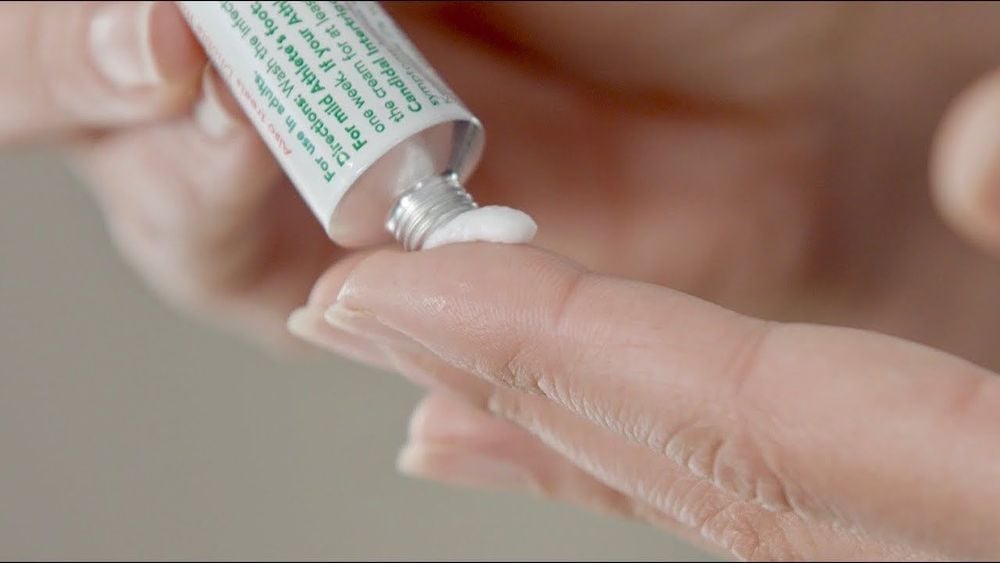
2.3. Onion Juice
The rich flavonoid content and antioxidant properties of this humble vegetable have been used for treating scars and dark spots since ancient times. Reports indicate that onion juice is extremely effective in reducing keloids and hypertrophic scars as well as reducing pain and inflammation during the healing process.
Apply fresh onion juice directly to the keloid 3-4 times a day to reduce the size and symptoms of newly formed keloids.
2.4. Garlic Oil
The presence of the active ingredient allicin in garlic prevents excessive fibroblast proliferation by blocking certain enzymes from entering the site that contribute to tissue and pigment buildup, leading to keloids. Therefore, garlic oil is not only a treatment for keloids but also helps improve blood circulation in the affected area, speeding up the healing process of the keloid.
Use a cotton ball to apply garlic oil to the newly formed keloid, leave it for half an hour, and rinse with cool water. Repeat this twice a day for optimal results.
2.5. Sandalwood and Rose Water
Both sandalwood and rose water have skin-regenerating, anti-inflammatory, and firming properties that have been known for creating great skin since ancient times. When applied together as a keloid treatment, this combination helps reduce itching, inflammation, and gradually shrink the size of newly formed keloid tissue.
Make a thick paste of sandalwood powder and rose water, then apply it to the keloid. Leave it overnight and wash it off in the morning. Do this every night to gradually remove the keloid.
In conclusion, because keloids are very difficult to treat, it is best to start treatment for newly formed keloids as soon as possible after injury, surgery, or piercings to optimize the results. Additionally, people who are prone to keloid formation should inform their doctor of this history so they can begin prevention right after surgery to minimize the risk of new keloids forming.
To arrange an appointment, please call HOTLINE or make your reservation directly HERE. You may also download the MyVinmec app to schedule appointments faster and manage your reservations more conveniently.
Reference sources: medicalnewstoday.com, aad.org, sodermix.vn, hienvanspa.com, benhvien115.com.vn